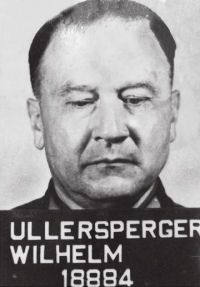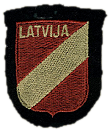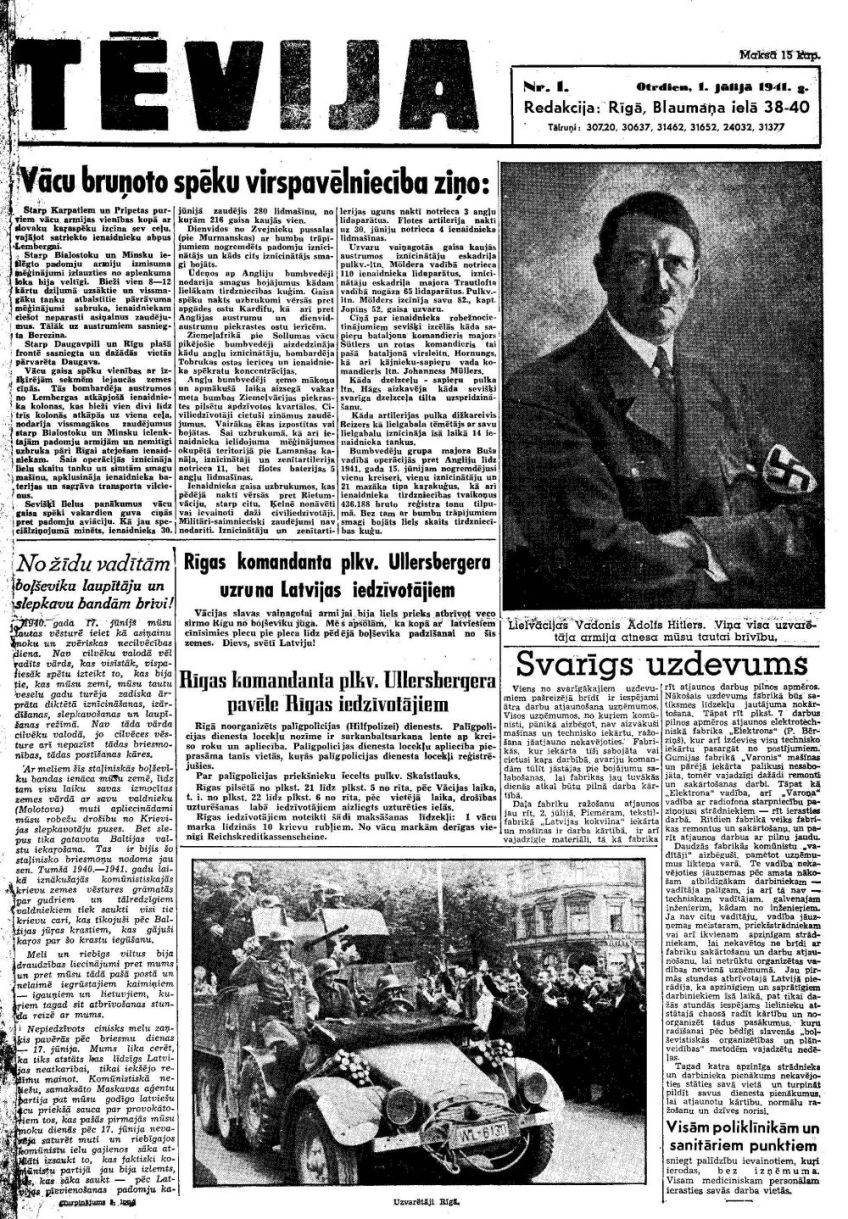8
of 1the ad hoc Latvian Self-Government on Merkela Street on July 1, where he received orders to chase "Russian soldiers" (tr.10271) north of the city who had been cut off by the north-easterly drive of the German army. In Riga itself, 2students and former members of the Latvian army immediately started to round up Jews. Even before the arrival of the German Einsatzkommandos, 400 Jews had been killed in pogroms. 9/ 3Many of those who were not killed were taken to the Prefecture. 10/ Some of the Jews were released after being harrassed and beaten; others were forced to work on details (tr. 472); some were detained and sent to the central prison.
4Three government witnesses testified that they were marched to the Prefecture during these early days. All three remember seeing Hazners there. Ber Mendelkorn, who was picked up in the "first days of ... July" (tr. 683) by "Latvians in civilian clothes" (tr. 184) 5lost three teeth after being hit by Hazners. He testified that he and other Jews in the courtyard were also beaten and kicked, (tr. 43, 455)
Mendel Wulfowitz was taken to the Prefecture in the beginning of July. (tr. 279, 2806) He described at length Hazners' role in baiting and harrassing the Jews in the courtyard of the Prefecture, (tr. 204-2187)
| 9/ | 6Operational Situation Report No. 24, p. 6 These reports were used to brief Himmler on the progress of the SS Einsatzkommandos in carrying out their task of "combating partisans and members of Resistance Groups, and exterminating the Jews and communists leaders, and other sections of the population." The Nurnberg Trial, 6 F.R.D. at 118. |
| 10/ | 7E.g. Mendelkorn, tr. 188; Wulfowitz, tr. 2089 |
Examination
This is not the Dankers Self-Government the INS falsely contends existed. What Latvians referred to as "pašvaldība" in the brief moments before the Nazis arrived and established control was meant in its sense of local autonomy, that is, Latvians in their local parishes, administered as pašvaldības before Soviet occupation banded together to insure departure of the Russians. As soon as the Germans arrived, they disarmed the population; moreover, civilian possession of firearms became grounds for being summarily shot.
The invading Germans did not even allow the Latvians to publish their own newspaper, let alone establish their own governing authority. The Nazis shut down Brīva Zeme ("Free Country") as quickly as it was established and replaced it with their propagandist Tēvija ("Fatherland"), its first issue published the very same day Rīga fell to the Nazis.
We should add that Hāzners was actually directed to another location where ad hoc Latvian volunteers were being organized to cut off the Russian retreat.
It is preposterous for the INS to suggest that the Nazis left the Latvians in charge of anything because they needed time to organize. [See following page.] A short article notes that Rīga Commandant Ullersberg10 had already set up a local "Hilfspolizei," installing a Latvian (judging by name), Skaistlauks, as its senior officer. This would indicate the "Hilfspolizei" reported in to the Wehrmacht. Ullersperger eventually returned to Germany to oversee fortifications in France, where he was captured late in the war.
2“students and former members of the Latvian army immediately started to round up Jews. Even before the arrival of the German Einsatzkommandos, 400 Jews had been killed in pogroms. 9/” . . . [footnote] 6“Operational Situation Report No. 24, p. 6 These reports were used to brief Himmler on the progress of the SS Einsatzkommandos in carrying out their task of 'combating partisans and members of Resistance Groups, and exterminating the Jews and communists leaders, and other sections of the population.' The Nurnberg Trial, 6 F.R.D. at 118.”
 General-Major Wilhelm Ullersperger as a POW. The Wehrmacht was in charge as soon as they entered Rīga.
General-Major Wilhelm Ullersperger as a POW. The Wehrmacht was in charge as soon as they entered Rīga."Reports" to Berlin of a spontaneous Germanless Holocaust were created for Nazi propaganda benefit and to camouflage the actions of the German Einsatzgruppen forces. Similar reports were filed for Lithuania, where a unit of Germans, not local Lithuanians as indicated, slaughtered Jews across the countryside. This is not to deny the Germans subsequently organized collaborators. However, the only thing happening in Rīga was celebration over the retreat of the Red Army. Subsequent German films shown to the press, narrated as Latvians rising up and beating Jews, actually featured German soldiers wearing German helmets.
The INS contends:
- that Latvians killed Jews before the arrival of the German Einsatzgruppen—they did not.
Reading the operational report, dated July 16, 1941 (more than two weeks into the occupation), reveals, first of all, that it stated nothing about Latvians killing before the Nazis arrived. Rather, it bemoaned the Latvians' passivity in response to the Nazi campaign to stir up anti-Semitic sentiment.
The report does indicate 400 Jews killed, after the German arrival, by the Einsatzkommando 2 ("EK 2") and their Latvian collaborators. Outside Rīga, EK 2 killed another 1,600 Jews, a total of 2,000 dead. We have highlighted the INS's contention and omitted context, cutting off their reading of the Nuremberg records in mid-sentence to substantiate a lie in their submission to the court.:
In Riga, Einsatzkommando 2 sifted through the entire documentary materials, searched all offices, arrested the leading Communists as far as they could be found. These actions initiated against the Jews were headed by SS-Sturbannfuhrer Barth and were carried out in an exemplary manner. At present, 600 Communists and 2,000 Jews are under arrest. 400 Jews were killed during pogroms in Riga, since the arrival of EK 2; 300 by the Latvian auxiliary police and partly by our units. The prisons will be emptied completely during the next few days. Outside of Riga, within Latvia, an additional 1,600 Jews were liquidated by EK 2.
The INS's contention that "students and former members of the Latvian army immediately started to round up Jews. Even before the arrival of the German Einsatzkommandos, 400 Jews had been killed in pogroms," citing the Nuremberg trial records, is a blatant lie.
3“Many of those who were not killed were taken to the Prefecture. 10/” . . . [footnote] 7“E.g. Mendelkorn, tr. 1811; Wulfowitz, tr. 20812”
We emphasize again that the Germans, not Latvians, were in charge. Under the Nazi occupational authorities, detained Jews were taken to one of three places:
- "Prefecture"—Riga City Militia Department Headquarters located at Aspāzijas bulvāris 7;
- “Zentralka”—the Rīga Central Prison; and
- Valdemāra iela (street) 19—a former Rīga police precinct building taken over by Viktors Arājs and his unit.
The Annas iela headquarters where Hāzners soon served as Veiss' adjutant, at his invitation, was established, via extensive testimony, to not have been involved in the persecution of Jews. The focus of the Kārtības Dienests functioning there was protection of strategic assets and support of Latvian combat units being organized and dispatched to the Eastern Front in pursuit of the retreating Red Army.
Hāzners was never stationed and never worked at the three locations listed above, nor did he ever have reason to be there.
4“Three government witnesses testified that they were marched to the Prefecture during these early days. All three remember seeing Hazners there.” . . . [Ber Mendelkorn] 5“lost three teeth after being hit by Hazners”
We expected to find that U.S. authorities had been influenced by Soviet propaganda in singling out Hāzners. We were disturbed to discover this closing brief—a summary of the U.S. authorities' case against Hāzners—tainted by propaganda and selective, even blatantly misrepresented, citations of Nuremberg trial records.
Armed with an understanding of where and how the Germans organized and executed the Holocaust, one witness placing Hāzners at the Prefecture—where he never served in any function nor had any reason to visit—is unlikely. That three witnesses place him there including knocking out people's teeth is suspicious and speaks more to the homogeneity of the witnesses' background as recent Soviet émigrés and being "discovered" and prepared for testimony by the same Israeli official than to additive accusations garnering credence.
Tripartite collusion in anti-Latvian accusations amongst:
- the Soviet Union providing fabricated evidence and unreliable witnesses—documented to have deposed the dead for show trials and accused children (at the time) of being Holocaust perpetrators;
- Israeli Nazi-hunters sharing the INS's belief that all Eastern Europe supported and were thus complicit in the Holocaust13 using grossly prejudicial methods for gathering witnesses—they provided seventeen Soviet émigré eyewitnesses after German investigations found no evidence against Hāzners and closed their investigation only two years earlier; and
- U.S. authorities—who because of the Holtzman Amendment were held to the lowest legal standard, having only to produce credible hearsay to deport individuals;
are understandable in this context. The best case scenario is that the INS failed to exercise due diligence and reproduced the contentions of others—perhaps because their attorneys and investigators took Waffen-SS service to indicate presumptive guilt of war crimes, per their earlier cited inference.14
| 1 | Testimony of Vilis A. Hazners, 8-March-1978, direct, transcript pp. 1019–1059. |
| 2 | Testimony of Ber Mendelkorn, 25-October-1977, direct, transcript pp. 15–93. |
| 3 | Testimony of Ber Mendelkorn, 25-October-1977, direct, transcript pp. 15–93. |
| 4 | Testimony of Ber Mendelkorn, 25-October-1977, direct, transcript pp. 15–93. |
| 5 | Testimony of Ber Mendelkorn, 25-October-1977, direct, transcript pp. 15–93. |
| 6 | Testimony of Mendel Wulfowitz, 27-October-1977, cross examination, transcript pp. 254–316. |
| 7 | Testimony of Mendel Wulfowitz, 26-October-1977, direct, transcript pp. 199–232A. |
| 8 | Testimony of Ber Mendelkorn, 25-October-1977, direct, transcript pp. 15–93. |
| 9 | Testimony of Mendel Wulfowitz, 26-October-1977, direct, transcript pp. 199–232A. |
| 10 | Wilhelm Ullersperger had served in WWI. Most of his military service in the 1930's and 1940's was as commander of engineering battalions. He was promoted to Colonel in October, 1940 and served as an officer in the Wehrmacht XXVI Army Corps invading Northern Russia. |
| 11 | Testimony of Ber Mendelkorn, 25-October-1977, direct, transcript pp. 15–93. |
| 12 | Testimony of Mendel Wulfowitz, 26-October-1977, direct, transcript pp. 199–232A. |
| 13 | Efraim Zuroff, the INS's researcher in Israel from 1980 to 1986, has contended in his books that the entirety of Eastern Europe "fanatically" supported Hitler's industrialized eradication of Jewry. |
| 14 | viz. also Efraim Zuroff's accusations submitted to Swedish authorities equating Waffen-SS service with war crimes. |

